Qat Wanders's Blog
December 1, 2024
cApItAliZatiOn bAsIcS
Does the title of this blog post make your brain hurt?
Me too.
To avoid things like that, let’s go over the basics of capitalization together!
When to Capitalize WordsThe beginning of every sentence
Dogs like to play fetch.What is your favorite movie?Proper nouns (an individual/specific person, place, or organization)Names: Harry Potter, Shaun, Mrs. Banks, Fluffy, Mom (not “my mom”), Senator RosalesPlaces: Brooklyn Bridge, Seattle, Canada, Main Street, New England, “He is Chinese,” “She speaks Spanish,” Mount Everest, Salt Lake.Organizations: Google, The New York Times, Washington Middle SchoolIn a book, an author might make up a proper noun of their own–like, “This is my Five-Step Plan for weight loss.” In that case, “Five-Step Plan” should always be capitalized and always look the same (remember that hyphen!).“I” –but not he, she, they.I love to swim.Dad thinks I’m going to be a great biologist someday. I think he’s crazy.Days, months, holidays–but not seasons or cardinal directions!Easter is held on a Sunday in spring, in either April or March.“The North Pole is about a hundred miles north from here,” he said.The Exceptions – Artsy CapitalizationSometimes, you will see things written IN ALL CAPITAL LETTERS.This signifies someone yelling, or otherwise acting very emotional.It is done to grab your attention (STOP signs, and YouTube video titles, EXIT signs)It should never be used in formal writing, and should only be used in creative writing sparingly (or risk having a lessened effect) Click here for more about All Caps Writing. sometimes people won’t capitalize anything at all.This is done by poet e. e. cummings to convey voice and a sad, melancholic tone.It should never be used in formal writingPerfectly “OK” in poetry writing.In creative writing, there should be a reason for it, and should be used sparingly (as it can be a bit headache-inducing to read over long periods of time)Sometimes people will use cRaZy capitalizationUsed to signify alarm, silliness, or uniqueness etc. in informal settings or memorable advertisement (FedEx, YouTube).Should never be used formally, and is never grammatically correct
Stick to these rules, and you’ll never have to worry about looking like that wAcKy bLog pOSt tITle!
~Christina
November 1, 2024
Working Emotion into Your Writing
The greatest compliment a writer can receive, in my opinion, is, “You made me cry.” Creating an evocative experience for the reader is a testament to what we artists strive to make. Writing, whether it is fiction or nonfiction, is meant to untangle our imaginative thoughts into memorable moments that will impact our readers for the rest of their lives.

How, though? How do we craft a work of art with jumbled words and jagged punctuation marks? How do we make delicate letters sing with the same beauty of a lone violin? Is there some secret out there that English teachers forgot to offer?
No, but there is a bit of psychology that we, as writers, tend to graze over—the difference between eliciting sympathy versus empathy.
Sympathy vs. EmpathyWhen a reader understands how the character feels, they are experiencing sympathy. If I were to tell you, “I’m happy,” you would connect that to your understanding of what it means to be happy and accept this as fact. However, hearing that I’m happy doesn’t automatically make you feel happy, yourself—or make you feel anything, for that matter. This is because understanding someone is happy is not the same as knowing why someone is happy.
When a reader knows the reason the character feels a certain way, they can relate to why the character feels the way they do—which allows the reader to experience empathy. If I were to tell you, “Today is the best day of my life. I have won the trifecta. My son was born, I got the bid on the house my husband and I were hoping to buy, and I received a promotion!” Your response to this might be, “Congratulations, I’m happy for you! Let’s go celebrate!”
See? My happiness becomes your happiness.
Show, Don’t TellIf you show why rather than tell what a character feels, the same can occur with the relationship between your characters and your readers. Showing what a character feels means exploring the whole spectrum of thoughts, words, actions, and eventually habits that encompass emotions like anger, sadness, fear, happiness, and love.
To become better at evoking empathy from your reader, it is important you become observant of those around you, and start to channel those observations into your writing. Here are some questions to consider when you observe yourself and others to better understand how to evoke empathy from your reader:
How do animals behave when they’re fearful?What are the expressions of humans who are experiencing a fight or flight response?What are habits that a person who’s been through domestic abuse displays?What’s something you do when you feel anxious?What speech pattern do people fall into when they are nervous? Confident? Excited?What thoughts enter your head when you’re happy?How does your body feel when you experience the first spark of love?How do you feel physically when you are around someone you are comfortable with?What are “tells” poker players report their opponents have?These questions and more await an answer. So, observe yourself, those around you, characters on television, and characters you experience through writings outside of your own. Then journal your experiences so you get used to formulating them in your own words. Finally, once you have written your next masterpiece, invite the reader into the perspective of your character—let them experience all the ups and downs and all the emotional nuances life has to offer.
Exercise:The five stages of grief are defined as: Denial, Anger, Bargaining, Depression, and Acceptance (DABDA). Write a passage (no more than 500 words) expressing a situation where your character experiences all five of these emotions through bodily sensations, thoughts, speech, and actions—without saying the name of the emotions you are trying to convey.
If you would like feedback on this and other exercises presented through the Wandering Words Media Blog, consider our one-on-one lessons, where we teach you not only how to write but how to craft art through the written word.
October 1, 2024
Why Knowing Your Genre (And Subgenre!) Is Important
What are genres and subgenres? Do they really matter? Does every book need to fit into one of these little boxes?
Today, we’re going to answer those questions by taking a look at how understanding the difference between genres and subgenres can help you craft a stronger story and a better marketing strategy.
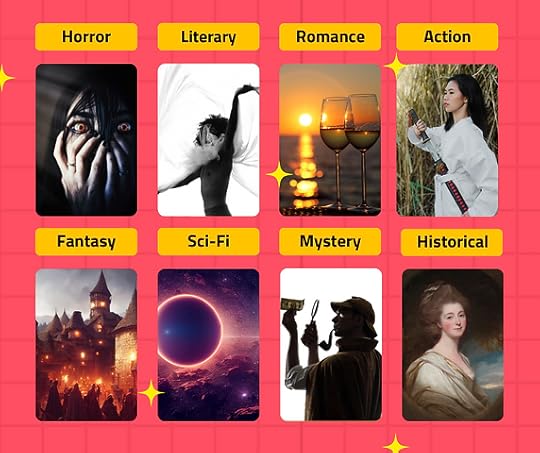
Genres are the big, overarching categories that classify different types of literature. Think of them as the main sections in a bookstore—in fiction, you’ve got your romance, mystery, fantasy, science fiction, horror, and so on. (In nonfiction, you have self-help, business, biography, textbooks, cookbooks, etc., but we’re going to focus on fiction today.) Each genre has its own set of conventions, themes, and expectations that readers have come to know and love.
Within each genre, you’ll find a whole bunch of subgenres. These are smaller, more specialized categories that further define the type of story you’re telling. For example, within the horror genre, you might have subgenres like splatterpunk, slasher, or creature feature. Each of these subgenres has its own unique vibe and audience.
Does understanding genres and subgenres really matter?As an author, knowing which genre your story falls into can give you a solid foundation to build upon. It’s like having a map—you know where you’re starting from and where you want to go. This can help you stay focused and ensure that your story delivers on the expectations of readers within that genre. You know that romance readers want a happily ever after, horror readers enjoy a strong Final Girl, and fantasy readers expect an element of magic. Knowing audience expectations can help you craft the plot of your story into one that people will actually want to read.
Let’s put it this way: if you picked up a book in the horror section of a bookstore, but by the end of the book there wasn’t a monster or a killer, and the two leads just happily fell in love and got married…you’d be disappointed, wouldn’t you? You’d at least be confused as to why it was in the horror section of the bookstore. Genre matters!
Going even deeper, by understanding the nuances of different subgenres, you can tailor your writing to appeal to specific audiences who are hungry for exactly what you’re offering. In other words, knowing your subgenre (and the tropes that go with it) can help you better “write to market” and create a solid readership for your book.
To put this into perspective, a reader is going to have a set expectation when they pick up a thriller, but those expectations will be different if they’re picking up a cyberpunk thriller, a romantic thriller, or even a historical thriller. Someone picking up an epic fantasy will be expecting an entirely different story than someone looking for an urban fantasy. It isn’t just the setting that changes within subgenres. Commonly used tropes, expected arcs, and even the themes change within subgenres.
That means each subgenre has its own map to follow. Knowing this in advance will make it that much easier for you to craft a plot that leads your readers down the road they’re hoping to travel.
Does every book need to fit inside one of these little boxes?For new authors, this might feel limiting. What if your book doesn’t really fit into any genre? What if it’s totally original?!
The tough-love answer is that it almost certainly either fits into a single genre, or spans a couple genres (we call that “cross-genre”).
And when it comes to cross-genre work, you’re going to have an entirely different hurdle to jump over.
If you plan on publishing traditionally, it may be harder to find an agent. After all, a cross-genre book is a harder sell! And if you’re planning on self-publishing, you’ll have a harder time marketing it.
Let’s look at the romance-fantasy genre for a solid example.
Fans of fantasy aren’t strictly going to be fans of romance. They might not want a romantasy book. And fans of romance may not like to read about elves and magic! That means your potential readers have just been cut in half.
That’s why, even within the concept of a cross-genre story, you’re going to want to know exactly what genres and subgenres you’re looking to explore. What are the standards of a romantasy? What are the standards of a horror-romance? They differ vastly from the standards of a straight horror—and your readers will be cut from a different cloth, too!
Don’t think of genres as limiting boxes, but as guidelines. Use that information to give you the kind of guidance you might need to make it to the end—and make some sales.
Of course, it’s okay to subvert expectations, take risks, and be original—you don’t have to write your book like a color-by-number. But genres exist to help the writer know what to write, and help the reader know what they might like to read. Don’t ignore these helpful tools!
~K. E. Koontz
September 1, 2024
Point of View – Who’s Tellin’ This Dang Story, Anyhow?
Many books have multiple POV characters, which means we get to see the story from many different angles. This can be done in either first or third person. Some books even use both, with one character’s portion being told in first person, and another character’s portion being told in third person!
This does allow the writer even more freedom, since they can explore aspects of the story that don’t happen in front of the protagonist (like, what the villain is up to).
For multiple POVs, it’s best if you only switch POVs on a chapter or section break. Switching too often or without intention can result in a book feeling confusing or jarring–many people call this “head hopping.”
If it’s your first book, it’s probably wise to stick to one head for now.
Books that have multiple POVs:
Frankenstein, Mary ShelleyMy Sister’s Keeper, Jodi PicoultTwilight: Breaking Dawn, Stephanie MeyerThe Da Vinci Code, Dan BrownThe Game of Thrones series, George R. R. MartinUltimately, whether you have one POV character or many, and whether you choose first, second or third, all depends on your story itself.Do you want to focus on one character, or many? Do you feel that your character’s voice and thoughts are important, or would it add to the tension if the reader wasn’t invited into their minds?
My suggestion is to write the first chapter in third, then rewrite it in first. Try writing with one POV, and see if you feel like the story needs another. Yes, it’s extra work, but it will be worth it in the long run, as it will help you figure out what works best with the story you’re writing.
You just might discover a skill or strength you didn’t know you had!
Happy Writing,
~Christina
August 1, 2024
Fantasy Worldbuilding Checklist
Want to create an immersive fantasy world for your readers? Not sure where to start or what to cover when it comes to worldbuilding? Feel like you’ve got most of worldbuilding covered, but wondering what you can do to make your world a complete, immersive experience for your readers?
Fear not! This Worldbuilding Checklist for fantasy world creators covers fundamental aspects of worldbuilding that will make your fantasy story come alive. (Sci-fi world creators may also find it helpful.)
It’s advantageous to start considering these before beginning, but they can always be reconsidered and expanded upon as you write. And having such a list to refer back to as you write can save a lot of time and effort.
The aspects of this checklist don’t have to be considered in order, but this list is organized in a top-down manner from the big-picture aspects of the world to the more detailed. Some of these will tie into each other, so moving on to another in the case of a mental block may help. Feel free to add as you go along and make this list your own.
This checklist was created with high fantasy in mind but can still be used for low fantasy. When creating more of a low fantasy world within our own, some of these worldbuilding aspects might not apply, but others will help to infuse fantasy into the reality of the human world.

Now that many of the aspects of your society and physical world have been fleshed out, think of the daily lives of your different characters and how aspects of the world will affect them. If you’ve already started writing, a period of reevaluation could be beneficial in order to create a more immersive world and realistic characters.
What would your characters experience daily?What little things do they do because of their world?Above all, what joy does their world bring them, and what sources of conflict? How can they overcome these?
It’s these little details of worldbuilding that will amaze readers and contribute to the overall picture of your fantasy (or sci-fi) world. It may seem like a lot, but considering and listing these worldbuilding aspects out will help immensely before and as you write.
Now go do your magic. You got this, world creator!

June 30, 2024
New Speaker, New Paragraph
Let’s focus on an often overlooked aspect of dialogue: how it should be structured within our paragraphs to maintain flow and clarity.
We like to throw the term “golden rule” around a lot when it comes to Writing 101. This is because each individual aspect of writing has a specific rule that needs to be followed for the rest of that area to make even an ounce of sense. When it comes to characters conversing with each other, the golden rule is simple:
New speaker, new paragraph.
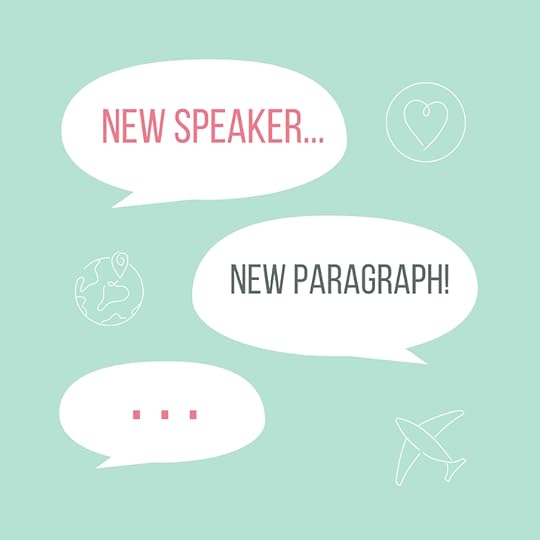
This simple guideline ensures that readers can easily follow who is speaking without getting lost in a jumble of words.
First, let’s look at the most common mistake:
“Did you see what he was wearing?” Kelly asked. Joan laughed. “It looked like a clown’s outfit!” “I know!” Kelly said, smiling. “I would never go out in public wearing those colors.” “I guess there’s a reason he never made it to the big leagues.” Joan shook her head. “Bad looks?” “Bad decisions!”
See how difficult it is to keep track of who’s talking? Now, let’s look at the same example, but with a new paragraph for each new speaker.
“Did you see what he was wearing?” Kelly asked.
Joan laughed. “It looked like a clown’s outfit!”
“I know!” Kelly said, smiling. “I would never go out in public wearing those colors.”
“I guess there’s a reason he never made it to the big leagues.” Joan shook her head.
“Bad looks?”
“Bad decisions!”
By giving each character their own paragraph, we create a visual rhythm that guides the reader through the conversation effortlessly. It’s like a dance, with each step leading gracefully into the next.
Actions as Dialogue TagsSomething else to keep in mind is that dialogue is often accompanied by actions, expressions, or gestures that enrich the scene and deepen our understanding of the characters. It can also help the reader keep track of who’s speaking.
Let’s see what a passage might look like with minimal action:
Riley shook his head. “I don’t know about this. “It’s fine.” “What if it’s not?” “I’m telling you, this is fine. You’re making it into a big deal.” “Maybe you aren’t making it into a big enough deal!” “Neither of you are looking at this right,” Chelsea said. “Get a grip.”
It’s pretty hard to figure out who’s saying what, isn’t it? While you don’t always need a dialogue tag, longer conversations can often benefit by an action or a reaction being included.
Riley shook his head. “I don’t know about this.
“It’s fine.” Sarah didn’t look at him.
“What if it’s not?”
“I’m telling you, this is fine. You’re making it into a big deal.”
“Maybe you aren’t making it into a big enough deal!” Riley jabbed a finger in Sarah’s direction.
“Neither of you are looking at this right,” Chelsea said. She gave both of her friends an unimpressed look. “Get a grip.”
Not only does the “new speaker, new paragraph” rule help make it visually easier on the reader, but including a few “stage directions” helps the reader gain a better feeling for the scene and for the characters themselves. Plus, adding the action in the same paragraph as the dialogue makes it clear who is speaking!
At the end of the day, your dialogue might sound great, but if a reader can’t figure out who’s saying what, the impact is going to be lessened by a vast amount.
Good luck!
~K.E. Koontz
June 13, 2024
How to Write like an Architect
Writing a book is like building a house. This metaphor makes understanding the writing and editing process a bit easier, especially for people who are new to it!
Often, people focus a lot on the finer details of a book—character names and hair colors, grammar and spelling, etc. These things are important, but just like how you wouldn’t move in all your furniture before the plumbing and electrical work was complete, you shouldn’t jump the gun here, either. There is a tried-and-true order for you to follow when it comes to constructing your book, just like when it comes to constructing a house.
Let’s take a look at the process together!
The Book Writing/House Building Process

As the author, this is your outlining stage. This is where you’re planning things out, before you ever break ground. You’re deciding the location of where you want to build (choosing your genre and topic) and beginning to sketch the story you want to tell and lessons you want to teach (drawing up the design of the house).

Once you have your plans in place, your next step is to start building the frame of the house. You lay the foundation, you put up wooden beams, you get the structure in place.
As the author, this is your very rough first draft.
You shouldn’t worry about the finer details yet. When you’re at this stage of building a house, you don’t need to know the color you’ll paint the walls, or where the sofa will go. When you’re at this rough-draft stage of writing a book, you don’t need to know your character’s hair color, you don’t have to worry about spelling and grammar, and you don’t need every sentence to be pretty or compelling, or even good. All that stuff will come later—for now, focus on building the frame of the house and getting it standing (getting a full first draft on paper, from beginning to end).

Now it’s time to get this house functioning. Plumbing and electricity bring the house to life. You technically don’t need them, but everyone wants them.
In a book, this refers to sprucing up your first draft with things you technically don’t need for the story to function at its most basic level, but you certainly want to have if you want your story to be any good. For fiction, this would be making sure the characters have an arc and grow and change. It might include adding subplots, twists, and making sure your themes are shining through.
We’re still working on a whole-house level here, so it’s still not time to worry about the tiny details. Don’t get distracted by those tempting things—buying paint and furniture is fun, but at this stage, it is a waste of time. Focus on what’s most important first.
Now, note: not everyone has central air conditioning, and your house might have more or fewer bells and whistles than another. Some books are more complex than others. That’s okay—you need some amenities, but you also may not need heated floors and multiple bathrooms. It all depends on the house you want to build and the story you want to tell.

This is where the house starts really looking like a house. At this stage, we’re still not painting anything, but we might be thinking about colors and furniture as we get the drywall up and the floors installs.
When writing a book, this is where you read through the draft from the beginning all the way to the end, like a reader would. Don’t make any changes directly on this read-through, but do leave notes to yourself in the comments in the margins. These notes should be about things you’d like to change, add, or delete. After you’ve read through the book fully (don’t skip that step, or you’ll get distracted and lost in the weeds), go back again and complete all the comments you’ve left for yourself. This step takes a lot of effort, but it’s extremely worth it in the end.
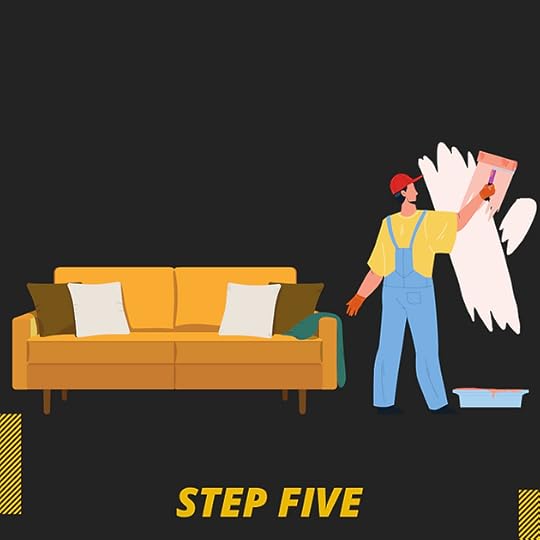
Finally, it’s time for the finer details!
Now that your larger structure is looking good and you’re happy with how your house is shaping up, this is where you can focus on your writing at a paragraph level. Here is where you’ll turn your focus toward things like descriptive details, voice, tone, character consistency, indirect repetition, poetic devices, and so on.
Here is where you should make the permanent decisions insofar as what each character looks like and what their names are. You decide to paint the living room green, and you decide to give Sarah red hair. Great—now, go through and make sure her hair is red throughout.
For this step, you’re reading the book again from beginning to end. Don’t jump around, or you’ll miss sections, forget things, and overall become quite confused. Stay organized.
Step Six: Settling an
 d Cleaning
d CleaningEverything is moved in, so it’s time to unpack your furniture and clean everything up from the move. In your book, it’s time to read through again and make sure everything looks how you want it to look.
And, finally, it’s time to look over your writing for spelling and grammar. This is the “cleaning” part of the process. Sure, it’s best if you try to have good spelling and grammar and keep the house clean throughout the building process, but it’s hard to keep 100 percent clean while a house is being built. Honestly, don’t worry about the mess—just get the dang thing build and wait until Step Six to start cleaning. Same with grammar—don’t worry about it for most of the process. You can clean it all up in Step Six, after you’ve stopped adding and deleting and moving big parts of the book around.

Final step. For the homeowner, this is a final touch-up before inviting people over for a housewarming party. For the author, this is the proofread, the last read-through before submitting the book for publication. You are checking for the final misspellings, missed inaccuracies, and little mistakes that fell through the cracks of the earlier steps.
Okay, so that’s how an author writes a book using the “building the house” metaphor…but where does the editor fit in?
Well, there are a few ways an editor might fit in, and which way an author chooses to use depends on the author’s personality, goals, and time commitment.
Some authors like to have an editor with them from Step One. In this case, the editor (or agent, book coach, private writing teacher, etc.) might help them outline their book, read and edit their first draft, and walk with the author every step of the way. This type of editing is like having a general contractor with you for the whole house-building process. While the author is the boss, the editor is helping them do a lot of the heavy lifting. The editor notices problems and offers solutions to the author on how to fix them (which the author may or may not listen to) while the book is being writing. The editor may even make changes (via Suggested Edits or Track Changes) for the author to approve or reject.
Having an editor by your side from the beginning is great for first-time authors and first-time home builders. But what if you’ve built a few houses now and understand the process a bit better? What if you want to be your own general contractor?
Experienced authors don’t bring in editors until they’ve done some or all seven steps outlined above on their own. Then, they bring in an editor. This has its own pros and cons—after all, if you’ve already done a ton of work moving in furniture but then the editor suggests knocking down and rebuilding the walls because they aren’t structurally sound, well, that’s a lot of wasted time and effort on the author’s part. The author may make that change and love it, but have to delete a bunch of work they might not have had to do had they brought in an editor sooner. Or, the author might shrug off the suggestion and decide not to do the hard work, resulting in a worse book.
Truth is, you can bring in an editor at any stage of the process, and ask them to focus on any step you want. You can write a rough draft (Step Two) and ask an editor to only check spelling and grammar (Step Six)—but just keep in mind that that would be like hiring an interior designer for a house that is just concrete and beams, or hiring a maid to clean your bathroom before the toilet is even installed. They’ll do their best, but there is so much big-picture work left to do on the book that their small-picture effect may be negligible. It doesn’t matter how clean a house is if there isn’t any plumbing!
When Should an Author Bring in an Editor?So, what do we recommend? When should you bring in an editor?
The answer is that it’s different for everyone, but here are some general ideas organized by each step of the process outlined above.
Step OneIf you are currently on (or have finished) Step One, Blueprints, and you’re not sure if your design is good enough, you might hire an editor to help you with your outline. You also might purchase some creative writing lessons to talk it out with a professional and notice any big problems upfront, before putting pen to paper.
Step TwoIf you have finished Step Two, Architecture, but feel stuck or uncertain, this would be a good time to ask for a beta read. With a beta read, your editor won’t worry about the finer details and will focus solely on the biggest picture items. This will help you ensure the structure and frame of your house are solid. They might suggest adding a room (adding chapters). They might suggest switching around where you put the kitchen (rearranging plot points). They might even suggest knocking down a portion of it to start over (i.e., rewriting sections), but it will be a lot easier to do so now than it would be after any of the following steps.
Steps Three and FourIf you are in Step Three (Plumbing, Electricity, Heating, etc.) or Step Four (Drywall, Flooring, etc.), and you aren’t sure what needs help or what needs fixing, what you need to add, what you need to change, etc., now is when you’d bring in a developmental editor. They will help you strengthen your story on a character, plot, and theme level.
Step FiveIf you are in Step Five, Painting the Walls, Moving in the Furniture, it’s time to bring in a content editor. They will look at your book on a closer level and help you decide which colors go best here, where to hang your artwork, which furniture you might need to buy or donate, and so on.
Step Six

If you are in Step Six, Settling and Cleaning, it’s time to bring in a copyeditor to check over your spelling, grammar, punctuation, and so on. They’ll also catch any awkward phrasing or other small issues the content editor did not address.
Step SevenFinally, at Step Seven, Polishing, it’s the proofreader’s time to shine. They’ll read over the book one last time, catching any dust bunnies or misplaced screwdrivers you may have missed on your cleaning process. After all, at this point, you’ve spent so long staring at the house, you may not even notice the little messes anymore—but their fresh eyes will.
Following the above guide, you’ll see that we always recommend an editor for Steps Five and later. Some authors might be able to hold off on hiring an editor until Step Five, but others may need (or want) help before that point. And every book is different—for one of my books, I didn’t send it to my editors until I finished all seven steps on my own, but for another, I was asking my editors to help on Step One. And I’m a professional editor!
When you need help, ask for it. Don’t just keep going, or you might end up making far more work for yourself than you would have otherwise.
Also, keep in mind that this isn’t always a linear process. Sometimes, things just aren’t working and you need to start over. Sometimes, you decide you want a ceiling fan after Step Seven and need to go back to Step Three to add in the necessary electrical work. That’s okay. Add it in, then do Steps Four through Seven on the area you needed to pull apart to get it back in working order. Sure, this takes more effort and time, but it will be worth it when you step back and see your beautiful fan spinning away.
Generally, no one would expect one person to build a house perfectly, every step of the process. It’s okay, and highly recommended, to ask for help at whatever stage you need help for.
Oh, and…if you’ve ever built a house, you know just how long it takes. It’s actually about the same amount of time it takes to build a book! Some are done in just a few months, but those are the outliers. Usually, it takes a year or more. Sometimes, delays can have it taking multiple years. Sometimes it’s done in a year, but a few months later you realize you need to make changes or additions.
Just as you wouldn’t rush a house, don’t rush the writing of your book.
The best things take time, and cutting corners is never a good idea.
Happy Building!
~Christina
May 30, 2024
Citing the Bible Like a Pro
So, you’d like to include some Scripture verses in your manuscript or blog post, but aren’t sure of the right way to format them—or even if there is a right way.
Let me assure you, there is a right way, according to the Chicago Manual of Style. CMOS sets the industry standard for proper grammar, syntax, and style found in most writing today: books, magazines, blog posts, etc.
I have some great tips and tricks on citing the Bible that I can’t wait to share with you. Let’s explore together!
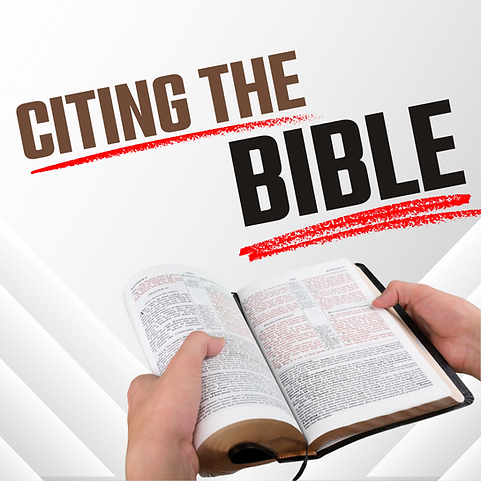
Right from the start, there is one big thing to keep in mind any time you quote Scripture: keep track of which version or versions of the Bible you used for each verse quoted. As you probably know, there are many translations of the Bible, and each one words things slightly differently. It’s perfectly OK to use multiple versions of the Bible in your piece, but you need to make sure the reader knows which version of the Bible each quote came from.
Tracking the translations you use while you’re writing will potentially save you hours of work later.
Including a Verse in WritingWhile there is a set standard, you still have some different options available as to how you share that verse.
Here are a few examples of including a verse in writing, all using the same verse:
Example 1: Paul writes in his letter to the Philippians, “Rejoice in the Lord always: and again I say, Rejoice” (Phil 4:4, KJV).
Example 2: In Philippians 4:4 we read, “Rejoice in the Lord always: and again I say, Rejoice” (KJV).
Example 3: What does Paul say to us? “Rejoice in the Lord always: and again I say, Rejoice” (Phil 4:4, KJV).
In each example:
The verse is written in quotation marks.The reference and version of the Bible (in this case, King James Version, abbreviated KJV) are included in parentheses.The punctuation for the sentence is after the closing parenthesis.There is no punctuation at the end of the verse within the quotation mark, unless it is a question mark or exclamation point.It is also up to you, the writer, to decide what format you prefer for the books of the Bible in your parenthetical references. Your intended audience may determine your choice. You could spell the entire book name, like Philippians, but it’s recommended to use an abbreviation like Phil.
If your quotation is from Kings, for example, you could also choose whether to use Roman numerals or cardinal numbers, II Kings or 2 Kings, though cardinal numbers are recommended.
Indirect QuotationsAnother option in your writing might be something like this: Paul reminds us in Philippians to always rejoice.
This is called an indirect quotation, since you are not quoting the Bible directly—rather, you are paraphrasing in your own words.
In this case, since there is no specific quotation, it can be left as is.
However, you may still want your readers to know where to find that verse. In that case, you could include a footnote at the end of the sentence, then provide the reference in your footnote.
Note that when indirectly quoting other things—research papers, for example—you have less leeway, and would need to add a proper citation for indirect quotations. For more help with citing non-Bible sources, check out our Citations Crash Course here!
Block QuotesIf you are including a lengthy passage of scripture in your writing, you may want to quote it as a block text instead of including it in paragraph form. This is recommended if the quote is longer than three lines or so. Like the examples above, you may want to reference the passage within your text prior to inserting the block.
It might look something like this:
Paul shares the vastness of God’s love for us in Ephesians 2:4–10:
But God is so rich in mercy; he loved us so much that even though we were spiritually dead and doomed by our sins, he gave us back our lives again when he raised Christ from the dead—only by his undeserved favor have we ever been saved—and lifted us up from the grave into glory along with Christ, where we sit with him in the heavenly realms—all because of what Christ Jesus did. And now God can always point to us as examples of how very, very rich his kindness is, as shown in all he has done for us through Jesus Christ.
Because of his kindness, you have been saved through trusting Christ. And even trusting is not of yourselves; it too is a gift from God. Salvation is not a reward for the good we have done, so none of us can take any credit for it. It is God himself who has made us what we are and given us new lives from Christ Jesus; and long ages ago he planned that we should spend these lives in helping others. (NLT)
Or, the reference could be noted at the end like this:
Paul shares the vastness of God’s love for us.
But God is so rich in mercy; he loved us so much that even though we were spiritually dead and doomed by our sins, he gave us back our lives again when he raised Christ from the dead—only by his undeserved favor have we ever been saved—and lifted us up from the grave into glory along with Christ, where we sit with him in the heavenly realms—all because of what Christ Jesus did. And now God can always point to us as examples of how very, very rich his kindness is, as shown in all he has done for us through Jesus Christ.
Because of his kindness, you have been saved through trusting Christ. And even trusting is not of yourselves; it too is a gift from God. Salvation is not a reward for the good we have done, so none of us can take any credit for it. It is God himself who has made us what we are and given us new lives from Christ Jesus; and long ages ago he planned that we should spend these lives in helping others. (Eph 2:4–10, NLT)
Again, the reference and/or version is noted within parentheses, but this time there are no quotation marks, and the punctuation is at the end of the verse.
Copyright Page
In a book, your citation for Scripture versions used will be included on your copyright page. If you only use one version of the Bible in your book, it would be stated there and the need to include the version with each verse quoted in the text would be unnecessary. If you use more than one version, then the most frequently used would not need the version noted in text, but all others would. Your copyright page notation would look something like this:
Unless otherwise indicated, all Scripture quotations are taken from the NEW AMERICAN STANDARD BIBLE, © 1960, 1962, 1963, 1968, 1971, 1972, 1973, 1975, 1977, by The Lockman Foundation. Used by permission. All rights reserved.
Scripture quotations marked (KJV) are taken from the King James Version of the Holy Bible. Copyright © 1972 by Thomas Nelson, Inc., Nashville, Tennessee.
Scripture quotations marked (MSG) are taken from The Message. Copyright © 1993, 1994, 1995, 1996, 2000, 2001, 2002. Used by permission of NavPress Publishing Group. All rights reserved.
I hope you’ve found this helpful, and it has cleared up some of the mystery for you regarding quoting Scripture verses.
~Tina
May 21, 2024
Indirect Repetition
If you’ve ever read a book and were bored, but weren’t sure why, indirect repetition was probably the culprit.
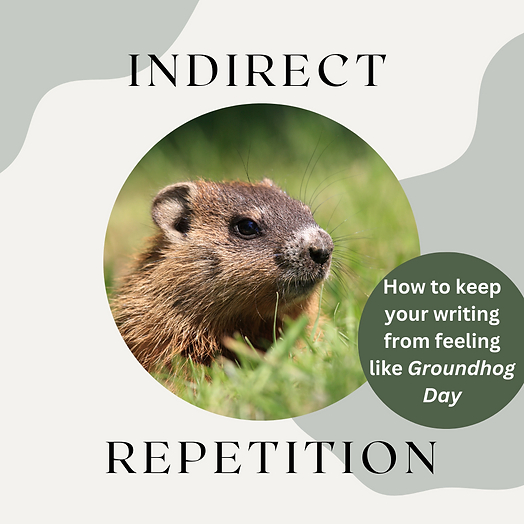
We’re all familiar with direct repetition. We’re all familiar with direct repetition. It’s like the first two sentences of this paragraph: exact copied text, shown to us twice. That’s pretty easy to find and fix, so that’s not our focus today.
We also might be familiar with plot repetition, when the same thing happens in a book’s plot more than once (maybe the princess is captured again and brought to a similarly challenging castle, or a nonfiction author teaches us the same lesson in Chapter 8 as they did in Chapter 2). That’s also important to look for, but today, we’re looking closer, at a paragraph and sentence level.
Our focus is a little harder to find than direct repetition and plot repetition, yet, it is just as important. Arguably, it’s more important, because it saves your book from being boring–and no one likes to read boring books!
What is Indirect Repetition?Basically, indirect repetition means saying the same thing twice (or more times), but using different words. Fixing this is a big portion of our jobs as editors, because it can be hard for an author to realize when they’re being indirectly repetitive.
Take this example:
She was beautiful. Gorgeous. I couldn’t take my eyes off her. Every eye in the place turned to look at her.
This piece of writing might seem fine at a first glance, but if you put on your editing goggles you’ll notice that it’s indirectly repetitive. The author used different words each time, but we learned the same piece of information (that she was beautiful) four times in a row.
Here’s another example:
The food was disgusting. It was the worst thing I’d ever tasted. It tasted like garbage and sweat.
Again, it might seem fine at first, but all we learn is the same thing, over and over: the food was gross.
Ask yourself what each sentence teaches the reader, on a basic level. If you find yourself teaching the reader the same thing, multiple sentences in a row, you’ve probably got yourself a case of indirect repetition.
Less is MoreWords hold more power when there are fewer of them. This is why cutting down on exclamation points, swears, screaming, crying, and other moments of drama helps your book. If characters are at a ten-out-of-ten the whole book, you’ll have nowhere to grow to when something really dramatic happens.
Same with repetition in description.
Now, this isn’t to say that you should only describe things with one detail each. Just make sure the details are all actually saying different things.
Fixing Indirect RepetitionSo, what can we do? Well, let’s look again at one of our indirectly repetitive examples:
The food was disgusting. It was the worst thing I’d ever tasted. It tasted like garbage and sweat.
Every detail here means, basically, “the food was disgusting.” So, either pick one detail (your favorite) and cut the rest, OR pick one detail, cut the rest, then add some more details that are not repetitive. Discuss some other aspect of the food besides its general badness.
Cutting all but one detail is great when you need to be short and sweet:
The food tasted like garbage and sweat.
If you can take your time, add some more, non-repetitive details. Explore other aspects of the thing you’re describing. Now is a good time to get into the other five senses:
The food tasted like garbage and sweat. The texture was of velvet and dish sponge, it was the color of rotten pistachios, and it was somehow cold and burning hot at the same time.
Go on and compare these “fixed” examples to the original, and you’ll see just how much stronger they are. Noticing and learning how to fix indirect repetition is definitely challenging, but getting a hang of it will improve your writing by a large margin.
And if you’re struggling, well, we’re here to help! A developmental/content edit will highlight these areas for you and offer solutions, and our private fiction lessons will build your skills in this area and more. Check out our services above, or email us for more info: wanderingwordsmedia@gmail.com.
Happy writing!
~Christina
April 30, 2024
How to Make Your Writing Flow
“It sounds clunky.”
“I can’t put my finger on it, but it doesn’t read right.”
“It needs to flow better.”
Sheesh, everyone’s a critic, am I right? How can writing be “clunky?” Also, if they can’t put their finger on it, why even mention it—and what is “flow” supposed to mean, anyway?
I get your frustration, which is why I’m here to explain what flow is, as well as what you can do to make sure it exists within your writing.
What is Flow?The reader is a kayaker, and the words on your page are the river they travel down. Your goal is to get the reader’s kayak down the river without the reader falling out of their kayak and drowning (getting overwhelmed or confused), paddling upstream (having to reread parts for clarity), or stopping on the embankment (putting your book down and giving up entirely). To do this, we want to create logical, linear, and smooth transitions between statements—especially in fiction.

Let’s break this down into three components: logical, linear, and smooth.
Logical FlowLogical flow refers to whether or not the organization of events in your story makes sense. Here is a snippet of writing that shows poor logical flow:
Ally, having just returned from the Grocery Store of Wonder, began to put her new food items away. Her mutant kitten with blue and purple stripes had refused to eat the last bag of barf kibble she bought, so this time she bought a special grave-robber surprise blend—guaranteed to have the best protein money could buy—but that needed to be refrigerated. Reaching into her grocery bag she pulled out the canned goods from Twaddle & Twit’s Processed Foods, and the bag—in its desire to help—threw up a bottle of Mad Hatty’s Insanely Good Sauce.
“I don’t need that yet,” she told the bag. “Now, where are those Heart Throb Instant Noodles they were selling in spades?”
She sets the bottle aside, digs around a bit more and pulls out—her kitten’s new food? No, she didn’t need that yet either.
I think we can all agree that the content of this passage is a bit outlandish, but did anything stick out to you or seem out of place? Did anything appear more like a tangent than information pertinent to the story? If you think the remark about the kitten food in the first paragraph is a bit off—and not just in taste—then you would be correct.
Logical flow is all about spotting awkward details that don’t fit with the surrounding content, and fixing or nixing them. Here is a version of that same snippet with logical flow:
Ally, having just returned from the Grocery Store of Wonder, began to put her new food items away. Reaching into her grocery bag she pulled out the canned goods from Twaddle & Twit’s Processed Foods, and the bag—in its desire to help—threw up a bottle of Mad Hatty’s Insanely Good Sauce.
“I don’t need that yet,” she told the bag. “Now, where are those Heart Throb Instant Noodles they were selling in spades?”
She sets the bottle aside, digs around a bit more and … pulls out—her kitten’s new food? Her mutant kitten with blue and purple stripes had refused to eat the last bag of barf kibble she bought, so this time she bought a special grave-robber surprise blend—guaranteed to have the best protein money could buy—but that needed to be refrigerated. So no, she didn’t need that yet either.
With each paragraph, we learn of new items this odd grocery store has to offer, and the kayaker doesn’t have to paddle upstream to review previous moments for clarity. The logical flow in this version of the example brings our kayaker to new and refreshing scenes without them having to put in too much effort.
Linear FlowLinear flow refers to whether or not the organization of events occurs chronologically. Here is a snippet of writing that shows poor linear flow:
My dog jumped over the fence, after he ran down the stairs and out the back door again! When the mailman arrived, my dog barked and went to greet him. The mailman, rather than running from him, went to give him a pet and a milkbone.
When you read that, you probably visualized the above snippet not as it happened, but as it is written, which means in your head you saw the dog jump over the fence before he ran down the stairs, and you’re probably not sure if he barked before he jumped the fence or after.
To create linear flow, we have to rearrange the sentences so that each sentence flows in a chronological fashion. Let’s try this:
When the mailman arrived, my dog barked and went to greet him. He ran down the stairs, out the back door, and then jumped over the fence—again! Thankfully, the mailman didn’t run from him, and instead he gave my dog a pet and a milkbone.
This correct version keeps our kayaker from not only having to paddle back up stream, but it also keeps them from having to attempt to do the hokey pokey while out on the river as they try to organize the order of events!
Smooth FlowA narrative with a smooth flow contains sentences that are worded in such a fashion that they appear to have arrived on the page with little effort. However, just like circus performers who make the near impossible seem easy, the same can be said for the experienced writer: practice makes perfect.
A book on the shelf has been through a multitude of revisions, and its author had a word coach—also known as an editor—to help them along the way (usually, they have more than one editor!). First drafts, no matter who they belong to, are always rough drafts, and every writer—no matter how skilled—has to refine the edges of their work through a revision process.
To get to the level of these “circus performer” writers requires lots of practice, reading your work, rereading your work, taking in all the feedback you can get, and revising what you have on the page.
It requires asking yourself constructive questions about your work, like:
Do the words I’ve chosen match the mood I’m trying to convey?Do I (or a friend) stammer and stumble over myself when I read what I have out loud—and if so, where within the narrative does this occur?When people read my work or hear it read out loud, does a quizzical frown form across their face?Don’t be upset or beat yourself up over the answers you may get. Instead, consider them, try to incorporate some more flow, see which version of your writing you like better, and grow from the experience.
Creating flow through the written word is about providing the reader with smooth sequencing that makes logical sense. Therefore, the objective of flow isn’t just about making your work sound as though it is rolling off the tip of the reader’s tongue; it’s also about engaging the reader in a way that allows them to have a more immersive experience through your writing voice.
By practicing these tips, you’ll create an enjoyable kayaking experience for everyone!
~Emma
Qat Wanders's Blog
- Qat Wanders's profile
- 19 followers



